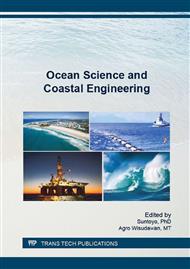p.127
p.132
p.138
p.144
p.154
p.161
p.168
p.174
p.182
Dynamic Modeling System for Analysis Smelter Development Plan in National Baluran Park, Situbondo
Abstract:
This Studies in several countries, the waste from the nickel smelter cause adverse effects on the environment, which indirectly affect the economy condition. Plan development of Nickel smelter which is directly adjacent to the national park Baluran in Situbondo quite disturbing some people. National park has a beach about 48 km long with a stretch of coral reef 5-10 meters out to sea into creating high productivity in these waters, especially various types of reef fish such as grouper. The highest numbers of catches are in district Banyuputih where the glaze was located 1734.65 tons in 2011, followed by the District Besuki with catches of 964.20 tons. In general activities in the nickel smelting are result some waste such as heavy metals such as Cu, Fe, Zn, Mn, waste heat from cooling water and wastewater canal SO2. Heavy metals and waste heatare potential adverse impact on the coral reefs, fish capture fisheries and the other marine commodities. While waste SO2 causes acid rain damage potential plant of agriculture, fisheries not only in the park but it could be damaging crops in the National Park that have an effect on the scenery, the number of visitors, and reduce operating revenues derived from the national park. We use the concept of gaming between actors to estimate the associated policy goal of this smelter. As for observing the behavior of the system over the next 10-30 years used the dynamics modeling system with 3 scenarios. Optimist scenario(there is Green smelter), excisting scenario(Condition without smelter) and pessimist scenario(there is non green smelter).
Info:
Periodical:
Pages:
154-160
Citation:
Online since:
January 2017
Authors:
Keywords:
Price:
Сopyright:
© 2017 Trans Tech Publications Ltd. All Rights Reserved
Share:
Citation:


